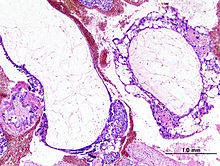Moles
| Classification according to ICD-10 | |
|---|---|
| D39.2 | Invasive moles |
| O01.0 | Classic mole |
| O01.1 | Partial or incomplete moles |
| O01.9 | Moles of bladder, unspecified |
| ICD-10 online (WHO version 2019) | |
The bladder mole or grape mole ( Mola hydatidosa ) is a disorder of embryonic development during pregnancy . An expansion of the small placental vessels leads to a blister-like transformation of the placental villi with melting of the surrounding connective tissue. The trophoblast shows an increased proliferation activity . A distinction is made between partial (90%) and complete (10%) moles. The transitions between the destructive (invasive) mole of the bladder and chorionic epithelioma are fluid and not uniform in the literature. Accompanying a mole of bladder, lutein cysts of the ovary up to the size of a child's head appear , which form as a result of the high secretion of gonadotropin ( hCG ) in the sense of an overstimulation syndrome .
Pathogenesis
A complete (complete) mole of the bladder occurs when the mother's single set of chromosomes in the egg cell is lost (by a still unknown mechanism) and the father's set of chromosomes is doubled. The result is a double set of chromosomes without maternal genetic material . Only trophoblast tissue develops from this, but no embryonic tissue. Malignant degeneration occurs in 20% of cases .
An incomplete (partial) mole of the bladder occurs when an egg cell that contains a single set of DNA is fertilized by two sperm cells or by a sperm cell with a double set of chromosomes. A triploidy of paternal and maternal origin results . Trophoblast tissue and embryonic tissue then develop from this.
Signs and diagnosis
Signs of a molar may include a particularly fast-growing uterus (womb), a highly positive pregnancy test , a lack of fetal heartbeats, and particularly severe pregnancy sickness.
The diagnosis is made via increased values for human chorionic gonadotropin ( β-hCG ) and the representation of the thickened placenta in ultrasound examinations .
Effects
In the presence of an embryo or an embryonic anlage, the consequence of a partial mole is the fruit abortion . In the case of the complete mole of the bladder, due to the pathogenesis (see above) and the uniparental double set of chromosomes, which comes exclusively from the father, normal development of the embryo is not possible. This is due to the different activation or inactivation of genes through imprinting . In the paternal uniparental set of chromosomes, individual genes are completely inactivated without a functional copy being present on the homologous maternal allele. Other examples of imprinting errors of only single chromosomes are Prader-Willi syndrome and Angelman syndrome .
If there is no embryo, an increased growth of the trophoblast takes place (sometimes also destroying the tissue of the uterus ), which can simulate an intact pregnancy.
treatment
Due to the given risk of degeneration of the moles, scraping or suction of the mole must be carried out. This procedure should be performed as soon as possible after the diagnosis is made. Then the blood levels of human choriogonadotropin (hCG) are checked until it is no longer detectable. Invasive moles are z. Some are also treated with chemotherapy , and they often respond well to monotherapy with methotrexate . The risk of repetition is around 1%.
literature
- Manfred Stauber, Thomas Weyerstahl: Gynecology and Obstetrics (= dual series ). 3. Edition. Georg Thieme Verlag, Stuttgart 2007, ISBN 978-3-13-125343-9 .
Individual evidence
- ↑ Hamid Emminger, Thomas Kia (ed.): Exaplan: The compendium of clinical medicine . 5th edition. Urban & Fischer in Elsevier, Munich 2007, ISBN 978-3-437-42462-5 , pp. 1833 ( limited preview in Google Book search).



